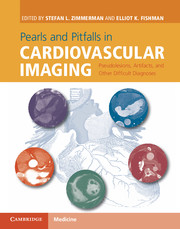 Pearls and Pitfalls in Cardiovascular Imaging
Pearls and Pitfalls in Cardiovascular Imaging from Section 8 - Post-operative aorta
Published online by Cambridge University Press: 05 June 2015
Imaging description
CT is the primary imaging modality used to evaluate patients after endoluminal stent placement. The role of CT is to confirm that the aortic pathology (aneurysm and/or dissection) has been excluded, demonstrate that the aortic branches remain patent, and to identify complications, most commonly the presence of an endoleak. An endoleak occurs when blood extends into the aneurysm sac outside of the stent, either by retrograde perfusion from an aortic arterial branch, leak from the proximal or distal end of the stent, or through the stent graft or where adjacent stent grafts overlap. Serial post-treatment CT imaging should demonstrate gradual decrease in the size of the excluded aneurysm sac. In the presence of an endoleak, the sac will stay the same or enlarge.
When performing CT after endoluminal stent placement, a precontrast acquisition is necessary for distinguishing calcification or surgical material within the aneurysm sac from an endoleak, and improves specificity and positive predictive value in identifying endoleaks. As shown in this case, high-attenuation calcification within an aneurysm sac can mimic an endoleak on post-contrast CT, but is definitively characterized as calcification by comparing to a non-contrast acquisition (Figure 67.1).
Importance
Calcification or surgical material within the aneurysm sac may mimic endoleak if only post-contrast images are obtained. Proper protocol design is an integral component to highquality diagnostic interpretation. Knowledge of pitfalls such as this mandates use of a precontrast acquisition following endoluminal stent placement to serve as comparison for the post-contrast sequences. Endoleaks may be followed if small, but can require reintervention. If left untreated, an endoleak can eventually result in rupture of the aneurysm sac.
Typical clinical scenario
Patients typically undergo lifelong serial follow-up imaging after the endovascular stent has been placed. Approximately 25% develop an endoleak, most commonly type II. Delayed endoleaks occur in 10% on average, with reports as high as 30%.
To save this book to your Kindle, first ensure no-reply@cambridge.org is added to your Approved Personal Document E-mail List under your Personal Document Settings on the Manage Your Content and Devices page of your Amazon account. Then enter the ‘name’ part of your Kindle email address below. Find out more about saving to your Kindle.
Note you can select to save to either the @free.kindle.com or @kindle.com variations. ‘@free.kindle.com’ emails are free but can only be saved to your device when it is connected to wi-fi. ‘@kindle.com’ emails can be delivered even when you are not connected to wi-fi, but note that service fees apply.
Find out more about the Kindle Personal Document Service.
To save content items to your account, please confirm that you agree to abide by our usage policies. If this is the first time you use this feature, you will be asked to authorise Cambridge Core to connect with your account. Find out more about saving content to Dropbox.
To save content items to your account, please confirm that you agree to abide by our usage policies. If this is the first time you use this feature, you will be asked to authorise Cambridge Core to connect with your account. Find out more about saving content to Google Drive.